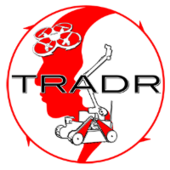TRADR is an EU-funded Integrated Project in FP7 that builds on the research and experience of the NIFTi project (www.nifti.eu). Using a proven-in-practice user-centric design methodology, TRADR develops technology for human-robot teams to assist in disaster response efforts, over multiple missions. The novel challenge is how to make experience persistent. In the TRADR scenario, various kinds of robots collaborate with human team members to explore the environment, and gather physical samples. Throughout this collaborative effort,
- the team gradually develops its understanding of the disaster area over multiple, possibly asynchronous, missions (persistent environment models),
- team members improve their understanding of how to work in the area (persistent multi-robot action models), and
- team-work is improved (persistent human-robot teaming).
To realise its main concept, TRADR formulates three scientific objectives.
- Persistent environment model: Develop S&T for the gradual construction of models of dynamic environments, fusing multi-modal observations from different kinds of robots, possibly operating asynchronously across multiple sorties during a mission.
- Persistent models for multi-robot acting: Develop S&T for the gradual adaptation and grounding of individual- and multi-robot task-level planning and execution within and across sorties, to reflect experience with operating in the disaster area.
- Persistent models for human-robot teaming: Develop S&T for the gradual adaptation of an individual robot’s social skills to reflect experience with collaborating within a human robot team.
The TRADR use cases involve response to a medium to large scale industrial accident by teams consisting of human rescuers and several robots (both ground and airborne). TRADR missions will ultimately stretch over several days in increasingly dynamic environments.
Partner
- Deutsches Forschungszentrum für Künstliche Intelligenz (DFKI) GmbH, Germany (co-ordinator)
- Technische Universiteit Delft, The Netherlands
- Fraunhofer-Gesellschaft zur Förderung der angewandten Forschung e.V., Germany
- Kungliga Tekniska Hoegskolan, Sweden
- Eidgenössische Technische Hochschule Zürich, Switzerland
- TNO, Soesterberg, The Netherlands
- Ceske Vysoke Uceni Technicke v Praze, Czech Republik
- Universita degli studi di Roma La Sapienza, Italy
- Ascending Technologies GmbH, Germany
- Stadt Dortmund, Institute for Fire Service and Rescue Technology, Germany
- Ministero dell'interno, Corpo Nazionale Vigli del Fuoco, Italy
- Openbaar Lichaam Gezamenlijke Brandweer, The Netherlands
- Nederlandse Organisatie voor toegepast-natuurwetenschappelijk onderzoek TNO, The Netherlands


